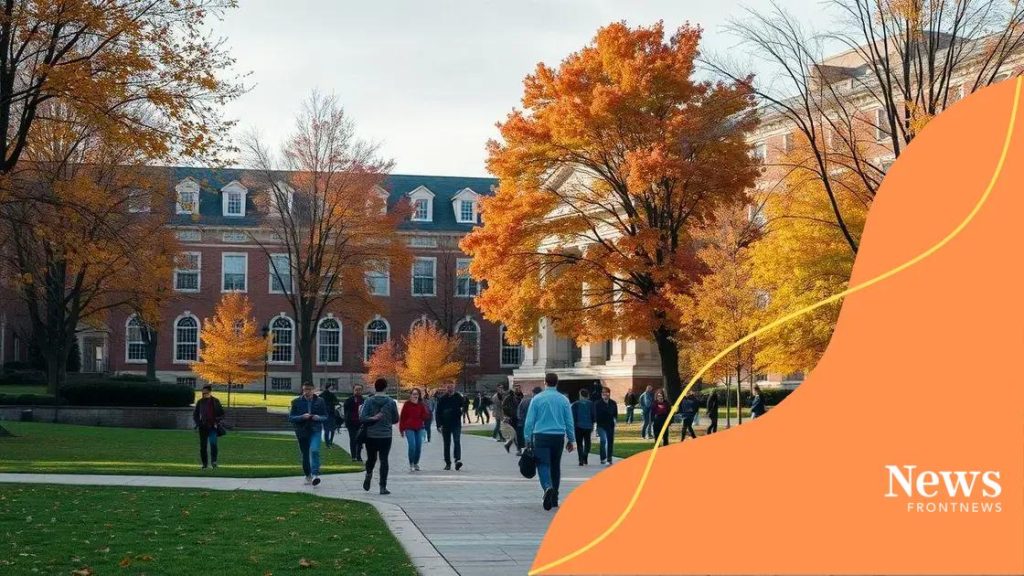University tuition freeze: what it means for students

A university tuition freeze maintains current tuition rates, providing financial stability for students and potentially increasing enrollment while impacting future tuition decisions.
University tuition freeze has become a hot topic in educational discussions. What does it really mean for students and their future finances? Let’s dive into the implications.
Understanding university tuition freeze
Understanding a university tuition freeze is essential for both current and prospective students. It can have significant implications for how much students pay over the years. A tuition freeze typically means that the university has decided to keep its tuition rates the same for a certain period, which can help students manage their educational costs.
When universities announce a tuition freeze, students may feel a sense of relief. Financial stability is crucial for many families, and knowing that tuition won’t increase can alleviate some financial pressure. In this article, we explore the reasons behind such freezes and their impact on students.
Reasons behind tuition freezes
Universities often implement tuition freezes for various reasons. Here are some common factors:
- Public pressure to keep education affordable
- State funding increases
- A need to attract more students
- A response to economic downturns
These decisions are usually strategic, aimed at improving accessibility for students. By freezing tuition, educational institutions can adjust their financial strategies while supporting students.
How tuition freezes affect students
Tuition freezes can benefit students by allowing for better budgeting. When tuition rates remain constant, families can plan more effectively for future expenses. Additionally, this freeze can lead to:
- Increased enrollment due to lower perceived costs
- Potential for more scholarship opportunities
- Enhanced focus on student services
Students might also experience a more stable academic environment. With lower financial stress, they can focus more on their studies and personal development. Overall, understanding the concept of a tuition freeze helps students navigate their educational journey more effectively.
Reasons behind tuition freezes
The reasons behind tuition freezes are varied and reflect many factors affecting universities and their students. Understanding these reasons can provide insight into how educational institutions are responding to economic and social pressures.
One important reason is the public demand for more affordable education. With tuition costs rising for many years, both students and parents have voiced their concerns. Educational institutions often listen to these voices to stay competitive and attract new students.
Impact of state funding
Another significant factor is the increased state funding for higher education. When states provide more financial support, universities may find it easier to keep tuition rates stable. This allows institutions to maintain programs without burdening the students.
- Enhanced funding can lead to better facilities.
- More scholarships may be available for students.
- Investment in faculty and resources can improve educational quality.
With state support, universities can alleviate the financial stress on students and focus on improving educational offerings.
Economic considerations
The current economic climate also plays a crucial role in deciding whether to freeze tuition. During challenging economic times, universities often implement freezes to support students facing financial hardship. It can help retain enrollment levels during downturns.
Additionally, universities must consider their competitive landscape. As more institutions adopt tuition freezes, others may feel pressured to follow suit. This ensures that they do not lose prospective students to cheaper alternatives.
Overall, these factors highlight the complexity of financial decisions in higher education. A tuition freeze can be a strategic response to maintain accessibility and quality for all students.
How tuition freezes affect students

The way that tuition freezes affect students can be significant and multifaceted. When universities choose to freeze their tuition rates, it often brings a sense of relief to students and their families. This decision impacts not just the immediate cost of education but also long-term financial planning.
Students benefit from predictable costs. With a tuition freeze, families can budget more effectively for their education expenses. This stability allows students to focus on their studies rather than worrying about rising tuition fees. Parents can feel more secure knowing what to expect each year.
Increased accessibility
Another advantage of a tuition freeze is that it can lead to increased accessibility for a wider range of students. More individuals may consider enrolling in college if they know their costs will remain stable. This can lead to greater diversity within the student body.
- Potential for higher enrollment numbers.
- A wider range of programs and services for students.
- Improved overall campus life and community.
These factors contribute to a richer educational experience for everyone involved.
Reduction in student debt
Furthermore, a halt in tuition increases can contribute to a decrease in student debt. Many students rely on loans to finance their education. When tuition rates rise, so does the amount they need to borrow. A freeze can lower the chances of graduating with crippling debt.
As a result, students may have more financial freedom after graduation. They can pursue their careers without the burden of paying off high-interest loans. This situation can lead to better financial health and greater life choices for graduates.
In summary, understanding the effects of tuition freezes helps highlight their role in promoting a more equitable educational environment. This initiative can encourage more students to pursue higher education, paving the way for a brighter future.
Comparing tuition freeze policies across states
Comparing tuition freeze policies across states reveals a landscape of differing approaches to higher education costs. Various states have implemented unique strategies to keep college more affordable for students. This analysis uncovers how these differences impact students and educational institutions.
Some states have adopted long-term tuition freezes, while others opt for temporary measures. Understanding these policies can inform potential students about their options. States with successful programs often show a commitment to making education accessible.
Long-term vs. short-term freezes
Long-term tuition freezes can encourage stability in educational costs. For instance, some universities in states like California and New York have maintained no tuition increases for several years. This steady environment can give students peace of mind.
- Consistent rates foster better family budgeting.
- Students can plan for unexpected expenses.
- Increased enrollment may lead to more resources for universities.
On the other hand, short-term freezes can be a response to economic crises, such as during a recession. States like Michigan have implemented temporary freezes, hoping to alleviate immediate financial pressures while assessing their long-term impacts.
Diversity in state policies
Each state’s policy also reflects its funding capabilities and educational priorities. States such as Texas might prioritize funding for low-income students, while others focus on maintaining overall affordability.
Overall, these policies highlight the complexities and variations among different states. As students navigate their college choices, understanding the local tuition freeze policy can significantly influence their education journey.
Future of tuition fees after a freeze
The future of tuition fees after a freeze raises many questions for students and educational institutions alike. When a university implements a tuition freeze, it often sets the stage for discussions about what comes next. Understanding these future implications is key for current and prospective students.
After a freeze, many universities face decisions about how to adjust fees moving forward. Some might choose to gradually increase tuition to keep up with inflation and rising costs, while others may focus on maintaining affordability. This decision can greatly impact students’ financial planning.
Cost considerations
As institutions evaluate their finances post-freeze, they often look at various cost factors. These can include:
- Increased costs for faculty and staff salaries.
- Rising operational expenses such as maintenance and utilities.
- Investments in new technology and resources for students.
Balancing these costs while keeping tuition stable is a challenge many schools face. If tuition does rise, students must be prepared for how it will affect their budgets.
Student enrollment trends
The freeze and any subsequent tuition increases can also influence enrollment trends. For instance, if students perceive that tuition is becoming unaffordable, they might consider alternative educational routes. This change could lead to:
- A decline in enrollment at some institutions.
- Increased competition among colleges to offer better financial aid packages.
- More focus on online education and lower-cost programs.
Ultimately, the decisions made after a tuition freeze will shape the educational landscape for years to come. These developments call for careful planning to ensure that education remains accessible for future generations.
FAQ – Frequently Asked Questions about University Tuition Freeze
What is a university tuition freeze?
A university tuition freeze is a policy that maintains the current tuition rates for a specified period, preventing increases.
How does a tuition freeze benefit students?
A tuition freeze helps students by providing financial stability, allowing better budgeting for their education without worrying about rising fees.
Can a tuition freeze lead to more enrollment?
Yes, by keeping tuition affordable, universities can attract more students, thus increasing enrollment numbers.
What are the potential long-term effects after a tuition freeze?
After a freeze, universities may eventually need to raise tuition, which can affect student debt levels and financial accessibility for future students.





